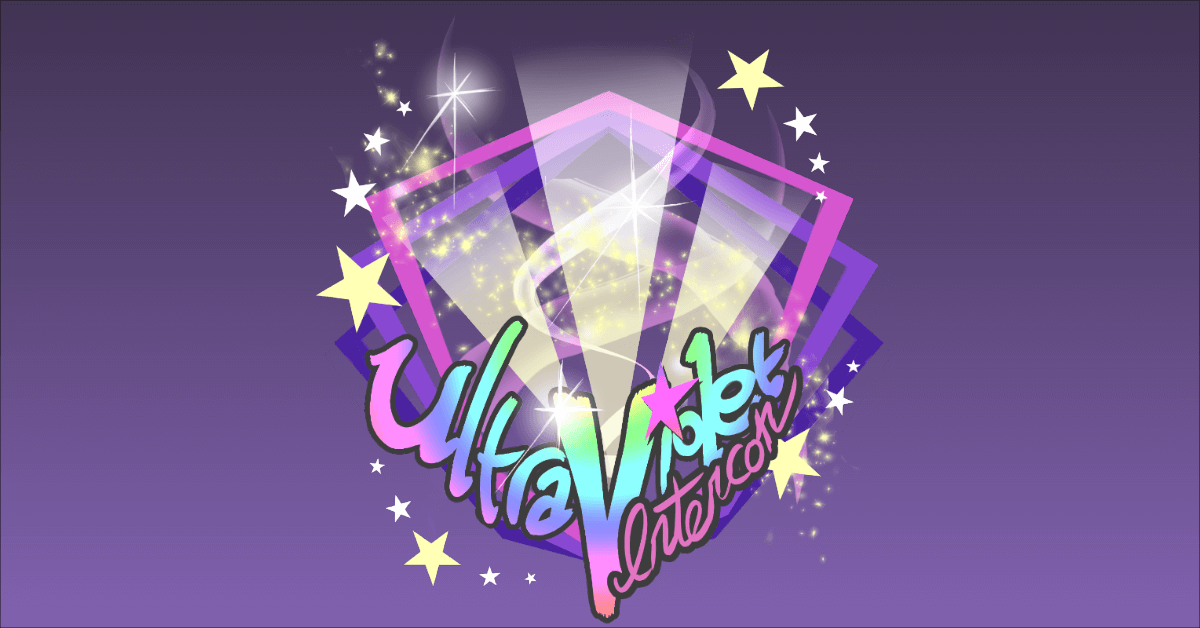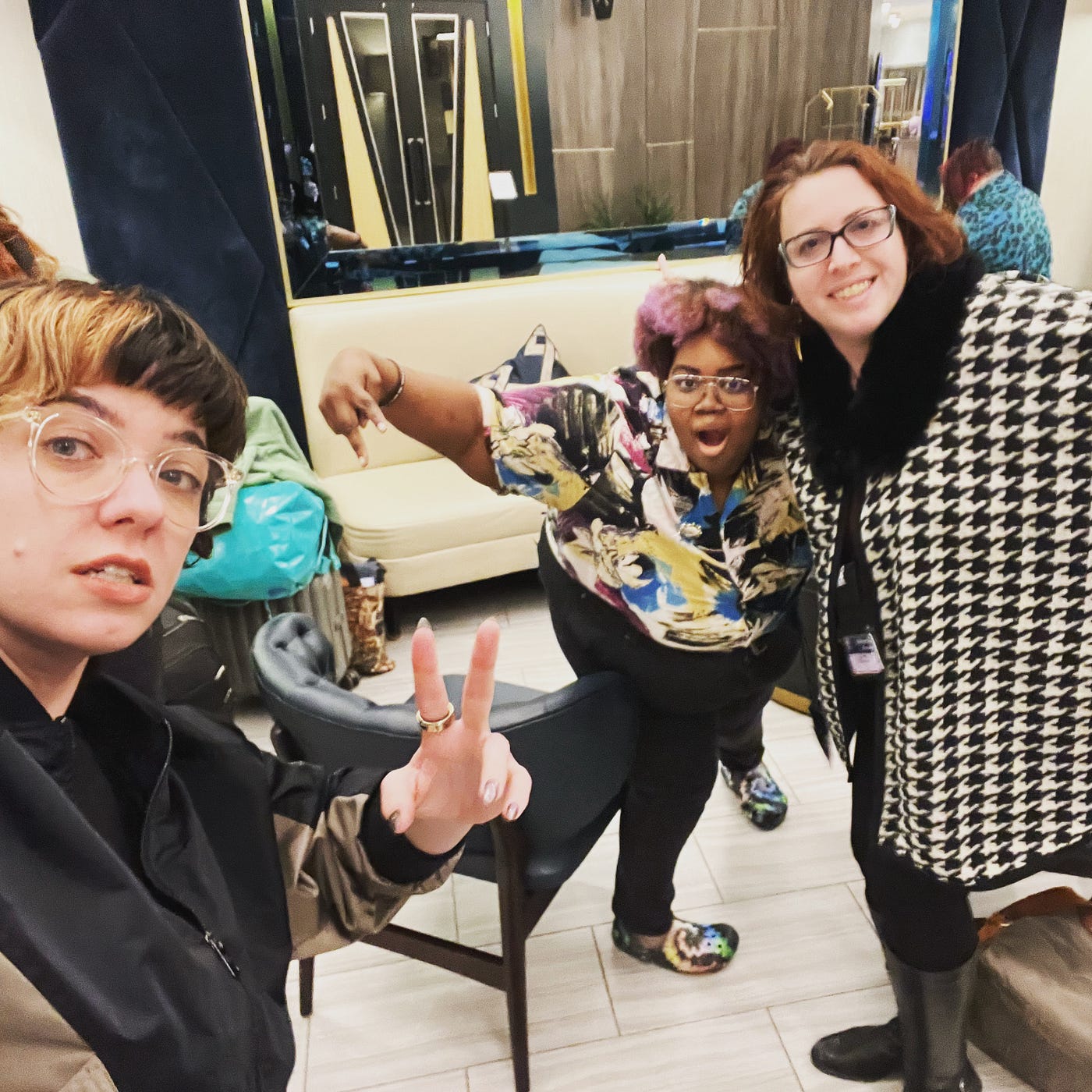Intercon U 2023 — A NoPro Diary
Our LARP correspondent reports back their experiences from this year’s convention


Intercon, the world’s “premiere multi-genre Live Action Role Playing (LARP) convention”, happened earlier this March, and NoPro was there — LARPing our little hearts out — so we could come back and tell you all about it. Leah Davis played eight of the 153 games available over the course of four days in Warwick, RI. There’s a lot to cover, so let’s dig in!
I love Intercon. It’s a chance to play multiple short-form LARPs without spending tons of money. But my Intercon Ultraviolet experience ended up being a little rocky, and I’d like to talk about why that’s a good thing. Overall, I’m thrilled to have attended and I’m already making plans to attend Intercon Voices in 2024 (all Intercons are named and themed alphabetically). I saw old friends, played new games, and dug deeper into what makes LARP and immersive work for me. I also played some games that left me cold. And that’s where we’re going to start.
Thursday, March 2
I wanted to make a clean break from reality going into this year’s con, so Mo Golden and Ross Cowman’s low-prep, contemplative Night Forest seemed like a good place to start. “There’s no plot and no character-driven roles or overarching goals”– just a bunch of strangers wandering around a dark room, describing real and imagined memories by candlelight. I had hoped that this game would set an adventurous mood for the rest of my con. Unfortunately, it didn’t.
Instead of feeling like I’d been transported to a liminal realm of physical memory, I felt frustrated by mismatched player energies and styles. Don’t get me wrong; Night Forest is great! The mechanics are elegant, there’s a lot of room for experimentation, and it’s suitable for all levels of player experience. But this was my reminder that even a well-designed LARP falls flat if players aren’t aligned. Intercon U’s run of the game suffered from a lack of pre-game workshops. We went over rules and safety mechanics, but we never talked about the space we wanted to build together, the world we were about to inhabit, or the story we were going to tell — all of that was either outlined in the rules or assumed. I usually love games with an overabundance of player agency, but that leeway meant that players chose to share memories from their past, imagined scenarios, and played in character. Playing on such a broad field made it hard for me to connect. Night Forest is a beautiful game that others in the room seemed to love, but I left it feeling isolated and alien.
Friday, March 3
Thursday’s game ended after one in the morning, so I did the smart thing and slept in. My first and only Friday game started at the civilized hour of two in the afternoon. Jamey Patten’s Before The Ordeal had been my #1 selection for Intercon U and I didn’t want to dilute the experience by rushing to or from something else. I wanted to be fully present, to wrestle with themes of duty, autonomy, violence, stoic masculinity, class, and exceptionalism — in a bathtub.

This game is designed for four people, each playing a squire on the verge of knighthood. Characters enter the ordeal chamber (the bathroom) and take turns experiencing visions of what their future might look like if they accept their vows. Patten wasn’t able to attend in-person this year, so our game was run over Zoom. This meant having to reserve 10% of my player-brain to ensure I was understanding instructions about how and when to share visions, read vows, and pour carafes of water over bathing-suit-clad peers during the game. Even so, this was a shining example of how much can go right when generous players take time to set expectations before jumping into a game.
The first hour was set aside for players to bond, answer questions, and discuss our character’s shared histories, and it made a huge difference. I was excited to play this run with people — including Dann Lynch, who had recently been a guest on the No Proscenium podcast, and LARPwrite Alyse Leung — who wanted to explore queer, trans, or nonbinary characters and relationships. Collaboratively, we decided that our training master had been a sharp-eyed woman named The Eagle, that knights were expected to be any gender, and that our cohort had become friends because we were misfits who had bonded after a rambunctious trip into town. We pulled these details from thin air, and they made our shared story that much richer. After three hours of play, it was easy to feel like I had grown up with these people. The pride we felt standing together to take — or reject — our vows was real… and satisfying.
Saturday, March 4
I was overly optimistic about my time management skills by Day 3, which meant I had booked three long-ish games between 11:00 AM and 11:00 PM. One thing I love about Intercon is that it’s an opportunity to check out games that I normally don’t gravitate towards (i.e. emotionally traumatic magical realism with low mechanics and no hit points). I like experimenting at Intercon because creators often run their own games, guaranteeing “as-intended” experiences for genre tourists like myself. My first two Saturday games, Who Killed High Hat? and Adrift On A Starry Sky, were my attempts to break the mold by playing comedy and sci-fi, respectively.

High Hat and Starry Sky are both excellent games — their worlds are richly detailed, their characters are robust, and each narrative is compelling. High Hat, by Brendan Adkins, Diane Glewwe, James Silverstein, Gaylord Tang, and Steve Vig is a Knives Out-style murder comedy where increasingly inebriated, loudmouth and sassy cretins argue about the death of a Kentucky Derby Racehorse. Starry Sky, by Jenny Diewald, Tim Lasko, Theresa Sullivan, and Gaylord Tang, sits at the other end of the spectrum, asking players to explore how familial, professional, and romantic relationships wax and wane over four decades of space travel in the wake of civilization’s collapse. Both games have rich lore, tons of backstory, well-defined characters, and enough player agency mixed in to keep things feeling fresh.
But, it turns out, that’s not enough to make a LARP work for me. Both High Hat and Starry Sky had me struggling to read and retain boatloads of information. Both games required breaking character to process new information mid-play. For High Hat, it was in the form of “action cards” that prompted characters to behave a certain way every time they had a drink. As for Starry Sky, there were scene breaks during which players would read a script that would inform the next scene. I hated feeling like I might mess up somebody’s game if I misremembered some critical piece of data, so I wasn’t able to lose myself in my character.
What I couldn’t deal with in these games was a lack of pre-game workshopping. I learned that I need time to level-set with other players before being able to transition into my character’s headspace. I want persistent play that doesn’t require breaking character. I want elegant in-game negotiation mechanics. I want to feel like my input is at least as important to the narrative as the creator’s original framework. And, while High Hat and Starry Sky might be enjoyed by those who like mechanics and foam sword fights, I’ve learned that they’re not for me.
My third game, Between the Penthouse and the Lobby, written and run by Andrea Humez and Alyse Leung, was another story. I’m glad I stuck around for this surprisingly nurturing, cathartic, and sometimes hilarious LARP. Between the Penthouse is a game about the decisions women make across generations and what might happen when those women get stuck in an elevator for three hours. This game also included a lot of pre-reading and required more detail-wrangling than preferred, but being able to play an expansive game about women that didn’t feel compelled to address the male perspective made it all worthwhile.

There’s a joke among women LARPers of a certain age that the only time they end up in game photos is when they’re in the background. So, having a LARP that put a spotlight on repairing familial relationships, debating the usefulness of women-only spaces, and arguing the ethics of selling a women-run start-up felt revolutionary.
It’s worth noting that all of the characters of Between the Penthouse identify as female, but that “players of any gender are welcome.” During our run, there was at least one male-identified player. During the game’s debrief, most of us talked about how our play had lifted up the collective narrative. In contrast, our male player spoke twice as long as anyone else about what he and his character had experienced. The more he spoke, the more I daydreamed about what I’d say to other men who want to embrace women’s stories through LARP: please join us! But cultivate self-awareness, cede the spotlight, and try to listen more than you talk when LARPing in women-centric spaces. Even so, this was an affirming, communal game that I was lucky to experience.
Sunday, March 5
I hadn’t meant to schedule two emotionally taxing games on my last day. Sure, I’d signed up for Kath Bryant’s post-apocalyptic Endlings on purpose. But I’d played B. Atwater’s Here Is My Power Button remotely over the pandemic so did I really need to play it again? Yes. I did.
Endlings was delightful. Most players in take on broad human archetypes like “parent” or “survivalist.” A few play as aliens. This low-prep game was exactly my speed; all I needed to do was show up in costume. We workshopped our human and alien worlds for 30 minutes before play started, each human choosing a few close relationships, a few rivalries, and a general sense of our group’s dynamics. Whatever the aliens workshopped was a mystery to me… until they came into the room with a crate full of detritus, planning to test and observe the humans.
This mechanic is what made Endlings a real standout. Bryant gathered a box of whatever she has lying around her house on game day before turning it over to the alien’s players for them to decide what happens next. In our run, the aliens asked us to divide an orange fairly, to recreate a scarf in 30 seconds using a screwdriver, yarn, and a crochet hook, to build something out of paperclips, and to describe human art through the lens of some crumpled sheet music. Together, we argued for the conservation of our species. And while we didn’t manage to secure their full support (our understanding of “sentience” was a little too narrow according to Earth’s “greater air fish” population), we did get humanity into a conditional pilot program. Success!

And then came Here Is My Power Button. It’s not weird for players to drop their last Sunday game after an exhausting weekend. So my run of Power Button was mostly populated by veteran LARPers, out-of-towners, and at least half a dozen last-minute wait-list additions. The energy in the room was electric. Game runners Ceridwen Pietras and David Neubauer smartly asked players to rank how intellectual and emotional they wanted to play on a scale of 1 to 10. Most players skewed towards the intellectual side of the equation. I went with “intellect 3, emotion 11”
Get Leah Davis’s stories in your inbox
Join Medium for free to get updates from this writer.
SubscribeSubscribe
The particular genius of Power Button lies in its structure: players are part of a consumer testing group researching the viability of AI companions. Gameplay is broken into two-part cycles. Each cycle starts with group feedback sessions for the humans and the AIs, during which information is shared amongst group members. The game runners, playing researchers, ask questions and give instructions. Then it transitions to one-on-one time between humans and their AI companions.
The stories that emerge are tragic without compromising humor or lightness, made possible by elegant mechanics that process out-of-game (OOG) information without having to break character. At one point, David made an in-character announcement that research had been going so well, we were going to be allowed a little extra time with our bots. In reality, he was telling us that we had extra game time to play another round. That level of synchronicity between player, structure, and game runner is what makes my very favorite kind of LARPs, like this one, shine.
After a long, busy weekend, I find myself thinking about what I experienced and learned — about play preferences, what kind of games I should pursue next year, and what it means to be part of the larger LARPing community.
Big takeaways from Day 1:
- I need to stop signing up for midnight games. Seriously.
- I like having workshop time to do collaborative world-building.
- Players are the most important ingredient.
- A little structure makes a big difference.
Big takeaways from Day 2:
- Pre-game workshops matter.
- LARP is imaginary, but the emotion it creates is real.
- LARP is a great place to explore different aspects of your identity.
- Four people in a bathtub can change the world.
Big takeaways from Day 3:
- Women-centered stories are essential and need to be told.
- Playing to lift makes everyone’s game better.
- There’s no such thing as a bad accent (just don’t be a jerk).
Big takeaways from Day 4:
- The best games find IG ways to share OOG information.
- Great LARPwrites leave space for player creativity.
Intercon’s patchwork of short-form parlor LARPs is a phenomenal place to experiment with genres, learn from one another, and grow as collaborative storytellers. All this time later, I’m still exhausted, managing bleed (the experience of feeling LARP emotions leak into real life), recovering from con drop, and I can’t wait until sign-ups open for Intercon V. November isn’t that far away, right?
Hope to see you there!

While Intercon U is over, those interested can go to the Intercon V website for details on next year’s convention.
Discover the latest immersive events, festivals, workshops, and more at our new site EVERYTHING IMMERSIVE, new home of NoPro’s show listings.
NoPro is a labor of love made possible by our generous Patreon backers. Join them today!
In addition to the No Proscenium website, our podcast, and our newsletters, you can find NoPro on Facebook, LinkedIn, YouTube, Twitter, Instagram, in the Facebook community Everything Immersive, and on our Discord.